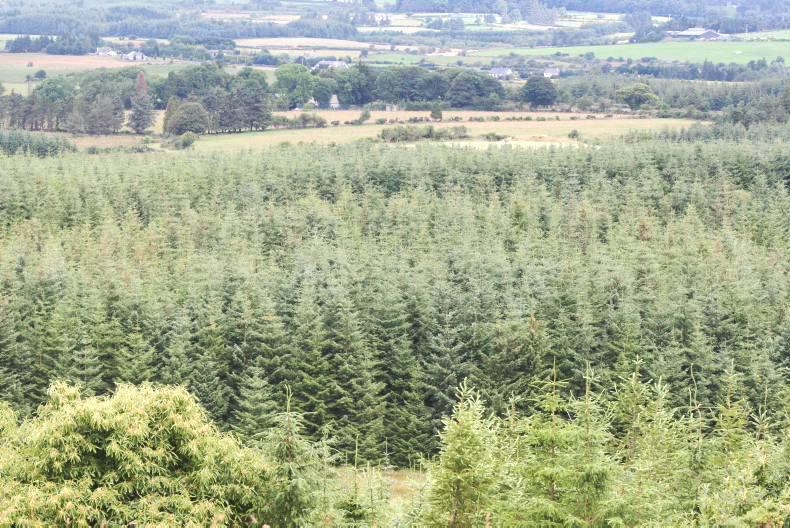Speaking at a briefing on Irish agriculture and climate change on Wednesday, Agriculture Minister Simon Coveney said that “afforestation is the most significant mitigation option” against climate change that’s available to Ireland’s land-use sector.
Minister of State Tom Hayes added that an important way of using this potential was to convert less efficient grazing land to forestry, mainly on beef farms.
While all types of Irish farming present opportunities to reduce greenhouse gas emissions through better practices, there is more room from improvement through afforestation (the conversion of new land to forests) than anywhere else.
This is helped by the fact that Ireland is starting from a low base: only 11% of our land is currently covered by forests, compared with an EU average of 32%.
According to Department figures, the 300,000ha of new forests planted since 1990 now absorb 18% of Irish agriculture’s annual greenhouse gas emissions. In addition, the use of wood as fuel or construction material replaces more carbon-intensive products derived from fossil fuels.
“Huge potential from marginal land”
Minister Hayes insisted that “the potential is huge in the amount of marginal land” that is currently used uncompetitively for other types of farming and would become more profitable under forestry. “We will try into the future to get that marginal land that cannot produce beef into forestry,” he said.
Income from forest harvesting was made entirely tax exempt in last month’s Budget announcement.
Listen to an extract from Minister Hayes’s presentation in our podcast below:
The challenge now for Ireland’s officials is to secure agreement at various levels to have the role of new forests recognised in international mechanisms to monitor climate change.
Next month’s climate summit in Paris is expected to set the rules until 2030, and Irish negotiators hope that countries will be allowed to consider emissions from all types of land use in their reporting – with carbon sequestration in trees partly balancing emissions from farming.
Another Irish demand is that any international agreement provides for incentives to develop afforestation and other climate change mitigation measures in the land-use sector.
EU leaders will then meet in early 2016 to decide how all these rules will be implemented across member states for the next 15 years, with Ireland again pushing to have its €3.5bn investment in new forests between 1990 and 2030 formally acknowledged as reducing greenhouse gas emissions.
Read a full report on Ireland’s strategy for agriculture and climate change in this week’s Irish Farmers Journal.
Read more
Survey shows that forestry income can be up to 57% higher than sheep farming
Forestry as a viable land-use option
Full coverage: climate change and agriculture
Speaking at a briefing on Irish agriculture and climate change on Wednesday, Agriculture Minister Simon Coveney said that “afforestation is the most significant mitigation option” against climate change that’s available to Ireland’s land-use sector.
Minister of State Tom Hayes added that an important way of using this potential was to convert less efficient grazing land to forestry, mainly on beef farms.
While all types of Irish farming present opportunities to reduce greenhouse gas emissions through better practices, there is more room from improvement through afforestation (the conversion of new land to forests) than anywhere else.
This is helped by the fact that Ireland is starting from a low base: only 11% of our land is currently covered by forests, compared with an EU average of 32%.
According to Department figures, the 300,000ha of new forests planted since 1990 now absorb 18% of Irish agriculture’s annual greenhouse gas emissions. In addition, the use of wood as fuel or construction material replaces more carbon-intensive products derived from fossil fuels.
“Huge potential from marginal land”
Minister Hayes insisted that “the potential is huge in the amount of marginal land” that is currently used uncompetitively for other types of farming and would become more profitable under forestry. “We will try into the future to get that marginal land that cannot produce beef into forestry,” he said.
Income from forest harvesting was made entirely tax exempt in last month’s Budget announcement.
Listen to an extract from Minister Hayes’s presentation in our podcast below:
The challenge now for Ireland’s officials is to secure agreement at various levels to have the role of new forests recognised in international mechanisms to monitor climate change.
Next month’s climate summit in Paris is expected to set the rules until 2030, and Irish negotiators hope that countries will be allowed to consider emissions from all types of land use in their reporting – with carbon sequestration in trees partly balancing emissions from farming.
Another Irish demand is that any international agreement provides for incentives to develop afforestation and other climate change mitigation measures in the land-use sector.
EU leaders will then meet in early 2016 to decide how all these rules will be implemented across member states for the next 15 years, with Ireland again pushing to have its €3.5bn investment in new forests between 1990 and 2030 formally acknowledged as reducing greenhouse gas emissions.
Read a full report on Ireland’s strategy for agriculture and climate change in this week’s Irish Farmers Journal.
Read more
Survey shows that forestry income can be up to 57% higher than sheep farming
Forestry as a viable land-use option
Full coverage: climate change and agriculture






 This is a subscriber-only article
This is a subscriber-only article










SHARING OPTIONS: